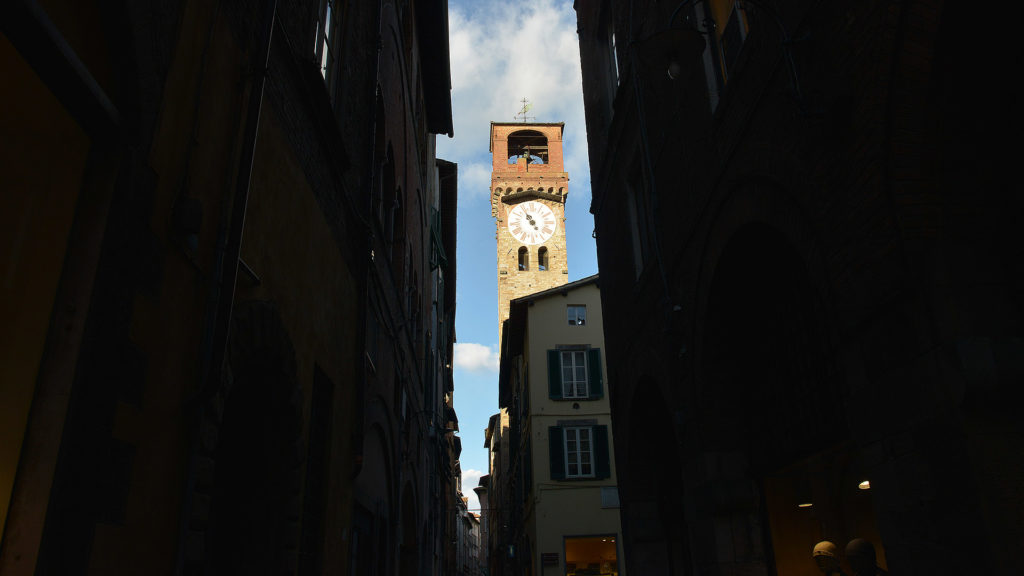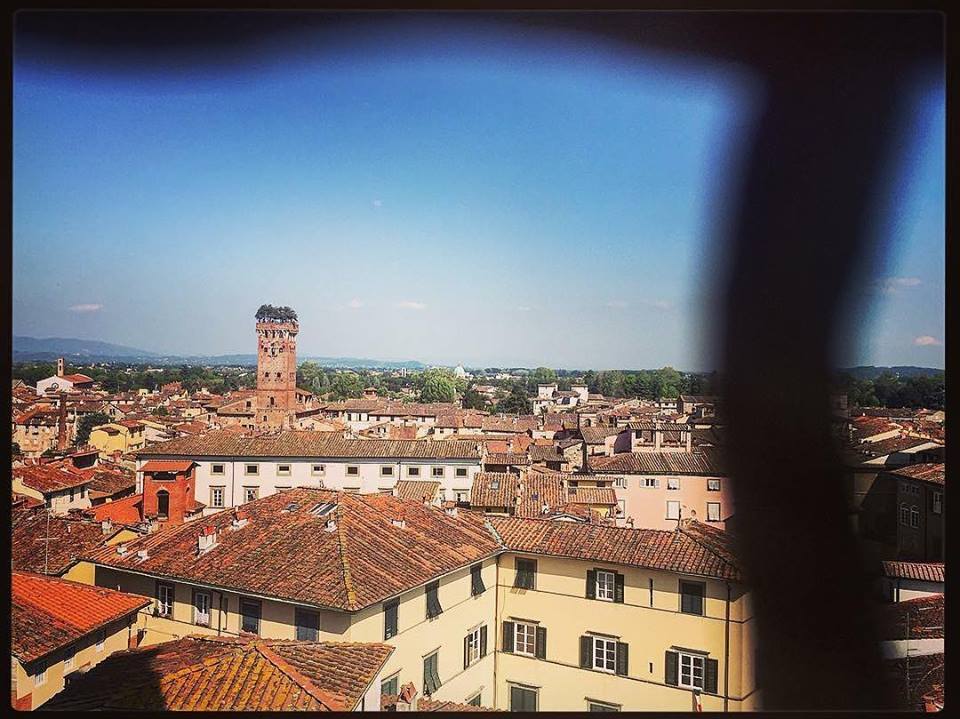
You could pass right beside it and not even notice.
Torre delle Ore, Lucca’s clock tower, is tucked away in a corner of Via Fillungo, amid other tall medieval buildings.
In the 13th century, the tower belonged to the Diversi family and then subsequently passed to other important families of Lucca. The change of hands was not always peaceable hence the nickname the “tower of dispute”. It wasn’t simply one of the many palazzo towers of medieval Lucca. It was one of the tallest of the city and its prime location on Via Fillungo made it symbolically unparalleled.
For this reason, the General Council of Lucca arranged to rent it and place a good-sized clock on it to mark the hours. In 1490, the Council finally purchased the tower and commissioned the most prestigious jeweler and goldsmith, Labruccio Cerlotti of Lucca, to make a new clock with a face and a single bell. From this central position, the hours were highly visible and the tolling of the bell, distinctly audible.
During the second half of the 18th century, time calculated Roman style with the day divided into four parts, each consisting of 6 hours of variable length based on sunrise and sunset, was gradually substituted by French time, used still today. With the latter, the day was organized based on when the sun was at its highest point, at noon. It was then divided into 24 hours of equal length: twelve hours before noon and twelve hours after. This, of course, was favored due to the diffusion of mechanical clocks. To have mechanical clocks keep Roman time was difficult: the clocks needed continuous adjustments creating continuous problems for the maintenance of the mechanisms. Under Napoleon’s reign, therefore, with the introduction of a unified system of measurement, the French method of telling time became permanent.
Consequently, clock faces and mechanisms of public clocks were modified as was the method of marking the hours: noon and midnight were twelve strikes each, one o’clock, one strike, two o’clock, two strikes and so on, twice a day. But not in Lucca. Lucca’s clock continued to strike from one to six strikes, four times a day.
In 1752, to keep up-to-date, the Republic of Lucca commissioned clockmaker, Louis Simon of Geneva, to construct a new modern mechanism. It was installed two years later with the collaboration of clockmaker, Sigismondo Caturegli of Lucca. Today, this is one of the most interesting models still functioning in Europe.
The new clock had a new face and three new bells, cast by founder, Stefano Filippi of Lucca. The hours were marked by the big new bell but still in Roman style, from one to six. The quarter and half hours were marked by the two smaller bells, as was the custom.

The belfry juts out from above the space where the clock mechanism is housed. It has four arched windows, a commanding view of the town, and on the roof is an iron weathervane with Lucca’s motto “Libertas” and the date, 1754.
These days, the clock has finally begun to ring again after a few years of silence thanks to a heartfelt restoration by clockmaker, Giovanni Ermini. The clock was disassembled and reassembled piece by piece, after having spent a lengthy stay in his workshop in Florence.
Two hundred and fifty years of dust, rust, and grease had accumulated on the gears, and were patiently cleaned with a large quantity of elbow grease by the clockmaker and other enthusiasts who would eagerly present themselves at the shop whenever the master clockmaker called them in aid.
While in Florence, the clock caught the attention of many passers-by and was the subject of many selfies. In fact, fascination for analogue clocks beats precision of digital clocks, 1-0.
Upon the clock’s return to Lucca, a digital controller was installed to replace the elderly city worker who would climb the 270 steps daily to hand wind the clock (a note for Millennials: there was a time, not so long ago, when clocks and watches had to be wound by hand. For example, to wind a watch, its crown, on the side of the dial, would have to be rotated using the thumb and index finger. If you forgot to wind it, it would stop, and you might have to ask someone in the street for the time, or rely on the sun.).
To not disturb residents with excessive bell-ringing at night, the clock has been programmed to mark the hours, quarter-hours, and half-hours between 8 am and 8 pm. I personally liked it when it rang 24 hours a day, but I can understand that it might be rather bothersome for residents.
Years ago, the then-mayor, Fazzi, was asked to stop the nighttime ringing of the bells. He personally polled residents to verify whether it was really a problem. After he spoke to my grandmother, he was quite satisfied because she assured him that the bells didn’t bother her in the least, she could barely hear them. However, she failed to mention that she was hard of hearing!
The Tower is also famous for its connection to Lucida Mansi, a beautiful and wealthy noblewoman. She lived in Lucca in the 17th century. They say that to preserve her beauty and youth, she made a deal with the Devil. When it was time to make good on her debt, the night of her birthday, 14 August 1623, she was so terrified of losing her life that she ran up the tower and attempted, but failed, to stop the bell from marking the hour of her death. Naturally, the Devil came to collect his due and carried her away….